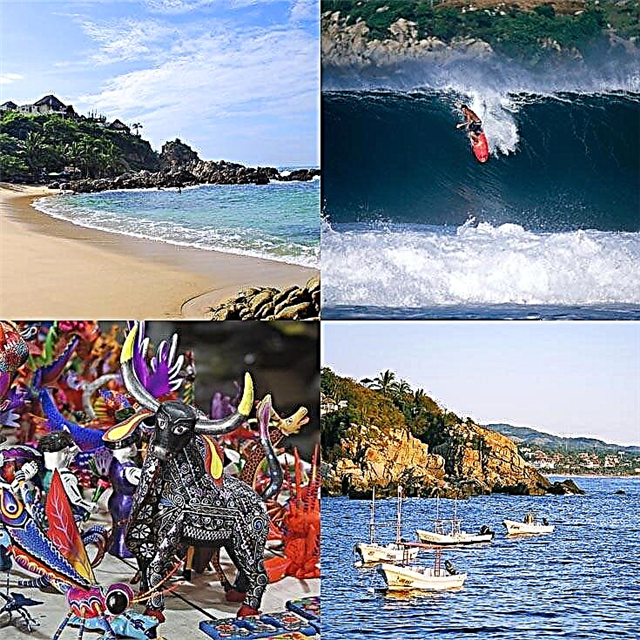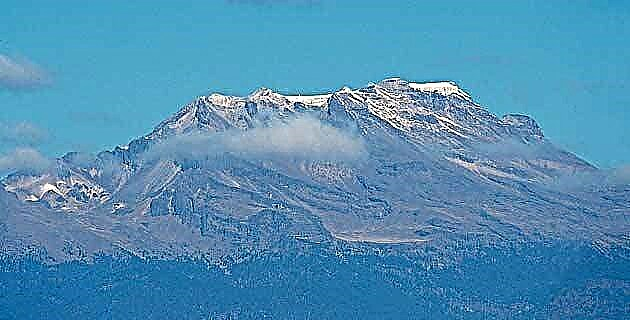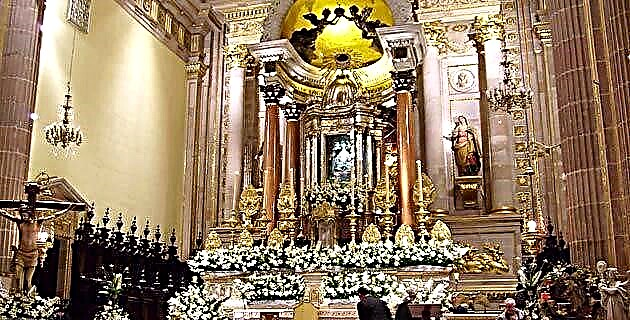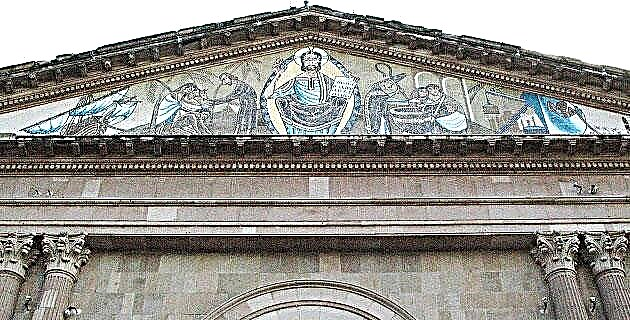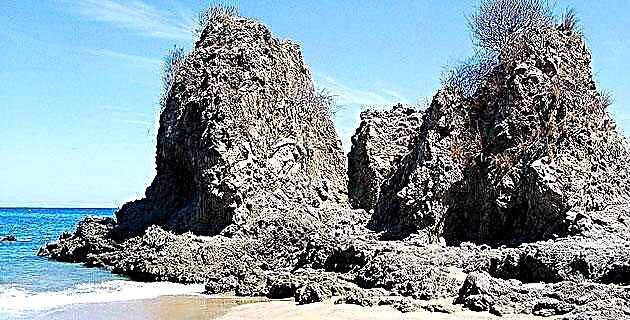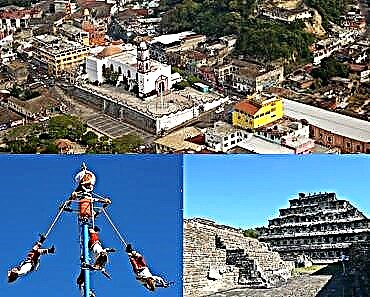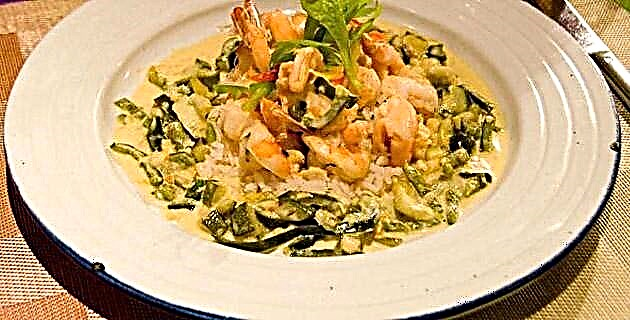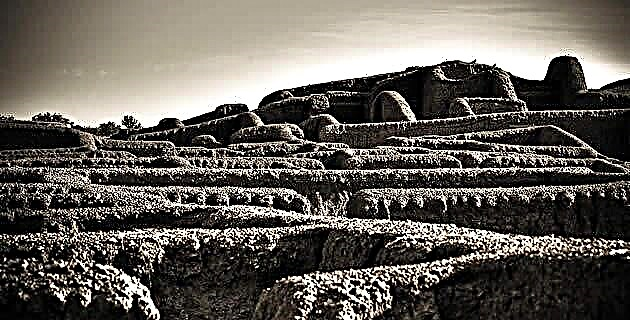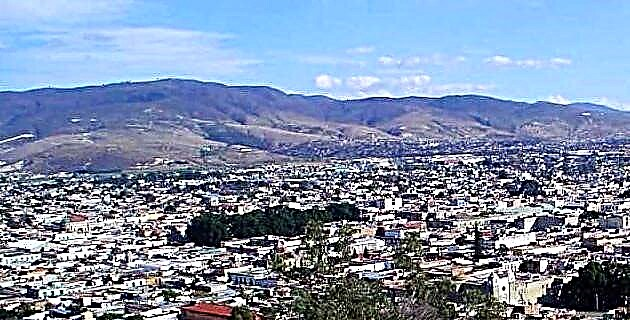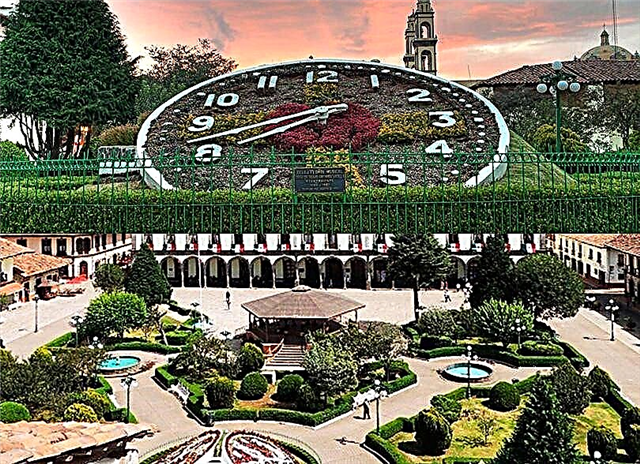The beautiful town of Zacatlán is a tourist site in the state of Puebla known as Zacatlán de las apples, for being the production of this fruit, an important base of its economy.
This charming place has for tourists its history, rich gastronomy, places to adventure, beautiful hotels and other attractions that can also be visited.
How Do You Get To Zacatlán De Las Manzanas?
 The town is the head of the municipality of Zacatlán, north of the state of Puebla and bordering the west with the state of Hidalgo. It is 191 km from Mexico City on Highway 132 D.
The town is the head of the municipality of Zacatlán, north of the state of Puebla and bordering the west with the state of Hidalgo. It is 191 km from Mexico City on Highway 132 D.
Every 60 minutes, a bus leaves for the Zacatlán station from the North terminal and the TAPO terminal, in the Mexican capital. The tour is approximately 3 hours.
Puebla de Zaragoza is 133 km from this beautiful town in a trip of 2 hours 40 minutes. The transport units depart from your bus station.
What Is The Weather Like In Zacatlán De Las Manzanas?
Due to its 2,000 meters above sea level in the Sierra Norte de Puebla, the climate of Zacatlán is cold, typical of the mountains. In the winter it approaches zero degrees and in the summer it averages 18 degrees Celsius.
The temperature reaches a maximum of 23 ° C in August, the month of celebration of the Great Apple Fair, which brings together the entire town in a cultural, gastronomic and musical festival.
What is the best time to go?
 Although any month of the year is opportune to visit Zacatlán and its tourist attractions, among them, architectural beauties and its floral clock, the ideal is to arrive between August 6 and 21 so that you know and enjoy its Great Apple Fair.
Although any month of the year is opportune to visit Zacatlán and its tourist attractions, among them, architectural beauties and its floral clock, the ideal is to arrive between August 6 and 21 so that you know and enjoy its Great Apple Fair.
What is the Zacatlán de las Manzanas Fair like?
The first Apple Fair was held in 1941.
A pyrotechnic show in front of the Municipal Palace marks its opening and closing. The program consists of fruit, artisan, industrial and culinary exhibitions.
Its parade of floats and pretty mountain girls who distribute apples presided over by the queen of the fair, is celebrated on the last day of the festival.
The fruit growers of Zacatlán are grateful on August 15, the day of their patron saint, the Virgin of the Assumption, for the success of the annual harvest.
In addition to apples, they offer to the Virgin and other fruits of the mountains are offered to the audience, such as plums, peaches, pears, blue cherries and quinces. There are also tastings of fresh and dehydrated fruit, sweets, ciders and liqueurs, in addition to the tasty Poblano cheese bread.
The festival is enriched with traditional dances, music and games. Tourists take souvenir photos in front of the Monumental Floral Clock, the town's emblem, and in other places of interest such as the Clock Museum and the former Franciscan convent.
Why is it considered a magical town?
 The Mexican government classifies some of the country's towns as "Magical" to distinguish and preserve their natural, physical and spiritual heritage. Zacatlán is one of 111 in the entire territory.
The Mexican government classifies some of the country's towns as "Magical" to distinguish and preserve their natural, physical and spiritual heritage. Zacatlán is one of 111 in the entire territory.
Its designation as "Magic Town" is a recognition of its natural beauty, architectural heritage, cultural and festive manifestations and gastronomic wealth.
When Was It Named Magic Town?
Zacatlán de las apples was declared a "Magic Town" by the Ministry of Tourism in 2011.
The localities with this category win a special financing program to improve their infrastructure and a high national and international promotion as a tourist destination.
Of the 111 classified nationally, 9 are in the state of Puebla. In addition to Zacatlán, these are:
1. Atlixco.
2. Cholula.
3. Xicotepec.
4. Pahuatlán.
5. Huauchinango.
6. Chignahuapan.
7. Tlatlauquitepec.
8. Cuetzalan del Progreso.
When was Zacatlán De las Manzanas Founded?
 The territory was inhabited by nomadic indigenous people during pre-Columbian times, their first Zacatecan settlement being between the 7th and 8th centuries.
The territory was inhabited by nomadic indigenous people during pre-Columbian times, their first Zacatecan settlement being between the 7th and 8th centuries.
The territory was conquered by the Chichimecas in the 11th century and later belonged to the Lordship of Tulancingo and the Mexica.
Although little is known of its colonial period due to the loss and destruction of documents, it is known that the first Spanish settlement was built in the mid-16th century.
The planting of apples began quickly and by the 18th century the town was popularly called Zacatlán de las apples.
The town was constituted in 1824 as one of the 22 Puebla departments, being the capital of the state when the Americans occupied Puebla during the intervention of 1846-1848.
In 1917 it became one of the 21 Puebla municipalities.
What Tourist Places Are There In Zacatlán De Las Manzanas?
The life of this Magical Town revolves around the cultivation and processing of the striped apple. Also to its main festivities to which are added the Cuaxochitl Indigenous Festival and in November, the Cider Festival.
The place has cozy cabins and ecological parks where you can spend days of adventure and fun.
The Barranca de los Jilgueros and the Valle de Piedras Encimadas are two places to admire, in addition to its architectural attractions of high historical, artistic and religious value, such as the former Franciscan convent, the temple of San Pedro and San Pablo and the Municipal Palace .
Its watchmaking tradition is over a century old with its beautiful town center floral clock and the Olvera family watch factory and museum.
What is the Cuaxochitl Indigenous Festival like?
 It is celebrated in May and is aimed at preserving and promoting the indigenous artistic manifestations of the region, such as its music, dances and gastronomy.
It is celebrated in May and is aimed at preserving and promoting the indigenous artistic manifestations of the region, such as its music, dances and gastronomy.
The word cuaxochitl comes from the Nahua words cua, which means head and xochitl, which means flower. For this reason the celebration is also known as the Flower Crown Festival.
The dancers show the people their skills in the dance of arches and weavers, a Puebla choreography that represents the rainbow over the flowers of the mountains.
The Maiden Cuaxóchitl elected from among the girls of the Nahua communities wears the beautiful typical costume that symbolizes her majesty.
To the cultural events are added the regional cuisine of indigenous roots and the sale and purchase of handicrafts made and made for the occasion.
When Is The Cider Festival?
As most of Zacatlán's apple production is destined to the manufacture of cider, the town is also known as, Cuna de la Sidra de México, where about 1 million bottles are produced.
This activity is so important that more than 25% of Zacatecos work in some branch related to the production of cider, from the planting and harvest of the apple, the care and maintenance of the plantations, to the production of alcoholic beverages. starting from the fermented juice of the fruit, as well as its packaging, distribution and sale.
Most of the cider is sold in Puebla and in the neighboring states, especially Veracruz, Guerrero, Mexico, Chiapas and Hidalgo. Also in other entities such as Mexico City and Aguascalientes.
The Cider Festival is held during the week after the Day of the Dead to promote the consumption of the drink and boost the regional economy.
The festival also serves to learn about the cider production process and to buy the drink at better prices, as well as the confections made by local artisans.
The industrial production of Zacatecan cider is in the hands of 4 companies that have kept their formulas since the 20th century.
These offer free tastings at the gates of the Municipal Palace and other points of the town, enlivened with music and other cultural events during the festival.
Where to stay in Zacatlán De Las Manzanas?
 The beautiful towns like Zacatlán are always accompanied by beautiful places of accommodation. Let's meet a few.
The beautiful towns like Zacatlán are always accompanied by beautiful places of accommodation. Let's meet a few.
1. Cabañas Una Cosita de Zacatlán: it is located on the 5th of León, San José Maquixtla, Colonia El Posito. There are 8 units with a craft shop built ecologically with the materials of the environment. Its restaurant, El Milagrito, prepares delicious Mexican and regional food. It has a bar.
2. Cabañas Los Jilgueros: in a beautiful corner of the Fraccionamiento Los Jilgueros near the ravine of the same name. Every morning you hear the singing of these beautiful multi-colored birds.
From its cabins built with wood and adobe you can admire the depth of several hundred meters of the Barranco de Los Jilgueros.
You can go hiking, trekking, mountain biking and rappelling. Also, camping. The complex has steam baths with traditional medicine known as, temazcal.
3. Campestre La Barranca: it has 22 cabins with a wood-burning fireplace and balcony to admire the ravine and listen to the chirping of birds. Its trajectory began in 1974 at Km 66.6 of the Apizaco-Zacatlán federal highway.
Its restaurant serves rich and varied Puebla cuisine such as tlacoyos, chili with eggs and chalupas. Also dishes of international cuisine that you can accompany with a wine from its own cellar.
To these 3 accommodation places are added the Cabañas Rancho El Mayab and Cabañas Boutique Luchita Mía.
The ex-Franciscan convent
The ex-convent is one of the oldest religious buildings in Hispanic America, built by the Franciscan friars who accompanied Cortés and his conquerors in the 1560s. It is also the oldest in which Catholic religious rites continue to be performed.
The conventual church has 3 naves; a higher central one and two lateral ones with towers of the same height, one with the bell tower and the other with a clock.
This jewel of colonial architecture was restored in 2009.
What is the interest of the Municipal Palace?
 Another of the architectural wonders of Zacatlán de las apples is its municipal palace, a two-level neoclassical building erected in fine stonework during the last quarter of the 19th century.
Another of the architectural wonders of Zacatlán de las apples is its municipal palace, a two-level neoclassical building erected in fine stonework during the last quarter of the 19th century.
On the ground floor of its main facade, 69 meters long, there are semicircular arches supported by Tuscan columns. The upper level harmonizes with the lower one with dust cover windows and a central tympanum with a clock.
The place in front of the Municipal Palace is a meeting point for important festive and civic events in this Magical Town.
What is the Temple of San Pedro and San Pablo like?
The eponymous saints of this parish are the patrons of the municipality of Zacatlán and their statues preside over the main façade that is shaped like an altarpiece.
The twin towers church was built between the late 17th and early 18th centuries. It is in the indigenous baroque style, an architectural concept called, Tequitqui, which is more sober than the European classical baroque.
How big is the Monumental Floral Clock?
 It is a huge and beautiful clock measuring 5 meters in diameter with a colorful background with flowers and green plants. It was a donation to the city of the Olvera family, the watchmaker family closely linked to the history of Zacatlán.
It is a huge and beautiful clock measuring 5 meters in diameter with a colorful background with flowers and green plants. It was a donation to the city of the Olvera family, the watchmaker family closely linked to the history of Zacatlán.
The floral clock is an icon of the place and is one of the first sites visited by tourists. It has a sound system with 9 musical sets that include Cielito lindo, Vals sobre las waves and México lindo y amar.
It is a work that works with electricity and a rope mechanism, which guarantees its operation during an electrical failure.
What's To See At The Watch Factory And Museum?
The watchmaking tradition began in 1909 by Mr. Alberto Olvera Hernández. Her children and grandchildren supported her by making great handmade watches with traditional techniques.
The floral clock was made in this factory, the first in Latin America to build monumental clocks.
The Alberto Olvera Hernández Museum of Clocks and Automatons was inaugurated in 1993. It exhibits a collection of pieces, machinery and objects, with which you can follow the evolution of the mechanisms that man has invented to accurately measure time.
Its visitors will also be able to discover the process of building a large format clock.
The Olvera family's museum and factory that is now called Centennial Watches, are based in Nigromante 3, in the center of Zacatlán de las Manas. Access is free.
Clocks Centenario has built pieces for churches, municipal palaces, historical buildings, parks, hotels, airports and other places, with pieces that mark the time in Mexico, the United States and Europe.
One of his most interesting creations exhibited in its spaces in the historic center of Zacatlán is a clock that marks the lunar phases in real time, the first in the world of its kind.
Where to Practice Adventure Sports?
 Adventure and mountain entertainment are guaranteed among the cool spaces and the mist of the mountains and the green foliage.
Adventure and mountain entertainment are guaranteed among the cool spaces and the mist of the mountains and the green foliage.
Stay at the Zacatlán Adventure, a boutique hotel focused on this type of fun with a camping area, hanging bridges, zip lines, a country house and an event room.
Its suspension bridges cross the forest at more than 30 meters high and its zip lines, more than 10 meters above the ground, allow you to admire the mountain flora.
The camping area is in a wooded area protected by more than 27 hectares and with secure camping areas 24 hours a day, which include bathroom services and hot water.
What Attractions Are There In The Barranca De Los Jilgueros Y Piedras Encimadas?
The spectacular ravine from which the mist emerges is populated by melodious goldfinches and with picturesque mountain hotels nearby.
The best point to admire it is the glass viewpoint, a place between clouds and a dreamlike view of sunrise and sunset. From there you can also see the beautiful Cola de Caballo waterfall in the distance.
Other waterfalls that are worth visiting are those in the Tulimán Ecological Park and San Pedro, with 20 meters high, which is on the way to San Miguel Tenango.
Near Zacatlán, in the community of Camotepec, is the Valley of Piedras Encimadas, a place with stones sculpted by nature for thousands of years up to 20 meters high. They are shaped like reptiles, birds, mammals, and sea animals. Nearby you can go hiking, biking and rappelling.
What to Buy In Zacatlán De Las Manzanas?
 In addition to the fresh, dehydrated apple and its derivative products in sweets, breads, cakes and drinks such as cider, soft drinks and juices, in this town there are beautiful handcrafted pieces such as sarapes, petticoats, overcoats and quexquémitl or neck tips . Also nice jewelry like earrings, bracelets, rings and necklaces.
In addition to the fresh, dehydrated apple and its derivative products in sweets, breads, cakes and drinks such as cider, soft drinks and juices, in this town there are beautiful handcrafted pieces such as sarapes, petticoats, overcoats and quexquémitl or neck tips . Also nice jewelry like earrings, bracelets, rings and necklaces.
You can buy beautiful clay work and wood carvings such as pots, jugs, plates, toys and ornaments.
Saddlers make belts, huaraches, harness, saddles and hats, while embroiderers make beautiful tablecloths, blouses and vests.
How is the food of the Magic Town?
In Zacatlán de las apples you can enjoy the best poblano and Mexican snacks.
The Sierra Norte de Puebla is the best place to taste lamb barbecue.
Its municipal markets are usually places to eat tasty and at a good price. The best is the barbecue in white, belly and lamb mixiote and warm the stomach with a tasty and nutritious consommé.
The coffee from the Sierra Norte de Puebla is of very good quality and in Zacatlán you can enjoy it in its coffee shops, one of them, the Café del Zaguán. Accompanying it with cheese bread is a delight.
El Chiquis Restaurant has a menu of Mexican food. Likewise, the Mar Azul seafood restaurant serves delicious seafood and Bistro Crepería, is the place to savor delicious crepes while watching the monumental clock.
Is there a tour of the apple plantations?
 Yes. There are walks with which you can admire the apple groves, learn about the history of the fruit in Zacatlán and its production cycle that includes planting, flowering, harvesting, pruning and other care.
Yes. There are walks with which you can admire the apple groves, learn about the history of the fruit in Zacatlán and its production cycle that includes planting, flowering, harvesting, pruning and other care.
The tours include visits to the fields and if it is in season, you can harvest the fruit with your hands. You will also test all the products.
What Are The Main Traditions Of Zacatlán De las Manzanas?
Holy Week is celebrated with all the typical fervor of Mexican towns, including a live representation of the passion of Christ, staged between the Guardian Cross and the Sanctuary of the Miraculous Lord of Jicolapa.
The Cuaxochitl Indigenous Festival or Flower Crown Festival, an event aimed at enhancing the indigenous culture of the Pueblo Mágico, is held in May in the central square.
The Day of the Dead is another highly respected tradition with an exhibition of offerings in the Portal Hidalgo of the Municipal Palace.
That day, the tasty pan de muerto stuffed with cheese and covered in pink sugar, the sour atole made with corn and the mole with turkey, a gastronomic symbol of the state, is exhibited and sold.
Visit Zacatlán of apples
 Zacatlán de las apples really earned the adjective Pueblo Mágico. Its traditions, history and tourist attractions invite you to visit it. Do not stay with this learning and live everything you have read.
Zacatlán de las apples really earned the adjective Pueblo Mágico. Its traditions, history and tourist attractions invite you to visit it. Do not stay with this learning and live everything you have read.
Share this article with your friends on social networks so that they are also encouraged to plan an early trip to this rich place.


